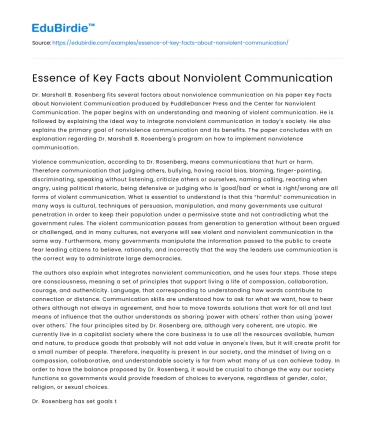Dr. Marshall B. Rosenberg fits several factors about nonviolence communication on his paper Key Facts about Nonviolent Communication produced by PuddleDancer Press and the Center for Nonviolent Communication. The paper begins with an understanding and meaning of violent communication. He is followed by explaining the ideal way to integrate nonviolent communication in today’s society. He also explains the primary goal of nonviolence communication and its benefits. The paper concludes with an explanation regarding Dr. Marshall B. Rosenberg's program on how to implement nonviolence communication.
Violence communication, according to Dr. Rosenberg, means communications that hurt or harm. Therefore communication that judging others, bullying, having racial bias, blaming, finger-pointing, discriminating, speaking without listening, criticize others or ourselves, naming calling, reacting when angry, using political rhetoric, being defensive or judging who is 'good/bad' or what is right/wrong are all forms of violent communication. What is essential to understand is that this “harmful” communication in many ways is cultural, techniques of persuasion, manipulation, and many governments use cultural penetration in order to keep their population under a permissive state and not contradicting what the government rules. The violent communication passes from generation to generation without been argued or challenged, and in many cultures, not everyone will see violent and nonviolent communication in the same way. Furthermore, many governments manipulate the information passed to the public to create fear leading citizens to believe, rationally, and incorrectly that the way the leaders use communication is the correct way to administrate large democracies.
Save your time!
We can take care of your essay
- Proper editing and formatting
- Free revision, title page, and bibliography
- Flexible prices and money-back guarantee
The authors also explain what integrates nonviolent communication, and he uses four steps. Those steps are consciousness, meaning a set of principles that support living a life of compassion, collaboration, courage, and authenticity. Language, that corresponding to understanding how words contribute to connection or distance. Communication skills are understood how to ask for what we want, how to hear others although not always in agreement, and how to move towards solutions that work for all and last means of influence that the author understands as sharing 'power with others' rather than using 'power over others.' The four principles sited by Dr. Rosenberg are, although very coherent, are utopic. We currently live in a capitalist society where the core business is to use all the resources available, human and nature, to produce goods that probably will not add value in anyone's lives, but it will create profit for a small number of people. Therefore, inequality is present in our society, and the mindset of living on a compassion, collaborative, and understandable society is far from what many of us can achieve today. In order to have the balance proposed by Dr. Rosenberg, it would be crucial to change the way our society functions so governments would provide freedom of choices to everyone, regardless of gender, color, religion, or sexual choices.
Dr. Rosenberg has set goals to explain why nonviolence communication is beneficial. According to him, if we provide a space where society can make their own choices, the population will connect in a meaningful way, and the relationships would be more empathetically and satisfying. If the correct environment provides a form of communication where everyone is more satisfied, less stressful, and calm, the way we communicate with one another will change. Unfortunately, humans have emotions, and it is required much self-knowledge in order to control emotions while communicating with one another.
Dr. Marshall B. Rosenberg created a program where anyone can learn and practice nonviolence communication to improve one relationship. Dr. Rosenberg makes a correlation with the way people were raised with the way they communicate. On his model he mentions that our society is educated from the beggining to compete, judge, demand, and diagnose, to think and communicate in equivalence of 'right' and 'wrong'. At best, the habitual ways we think and speak hinder communication and create misunderstanding and frustration. Furthermore, this type of communication can cause anger and pain and may lead to violence. Without wanting to, even people with the best intentions generate needless conflicts. Therefore, nonviolence communication helps people to learn and develop a vocabulary of feelings and needs that helps people to express what is going on with themselves and others. He author believes that when people understand and acknowledge their own needs, they can develop a shared foundation for many satisfying relationships. There are many challenges with Dr. Rosenberg's model. The first challenge is that the nonviolent communicator has his assumption and interpretation regarding a particular behavior.
Additionally, the expression of feelings and needs can be painful to the extent that people do not understand their feelings and needs; this requires a certain level of self-knowledge. Often, the use of the program probably will make people feel awkward, and they eventually desist in using it every day for fear of appearing too soft. Moreover, the expression of a clear, doable, affirmative action demands a high level of nonviolent communication knowledge. It often takes a long time to be able to achieve an appropriate nonviolent communication wording of the affirmative action. It demands time, reflection, patience, and discipline, which many times is not possible to manage in real-life situations.
In conclusion, Dr. Marshall B. Rosenberg's nonviolent communication model has a more significant potential to change the way society communicates with one another. Nonviolent communication fosters empathy, which is forgotten in today's society. The nonviolent communication model offers advantages, tools, and processes to anyone willing to learn different ways of communication, providing, therefore, empathy enhancement, conflict resolution skills, communication skills, and relationship improvements. The difficulty is that this model can provide changes for individuals willing to learn and apply the model, but it is challenging to make this model worldwide applicable.






 Stuck on your essay?
Stuck on your essay?

